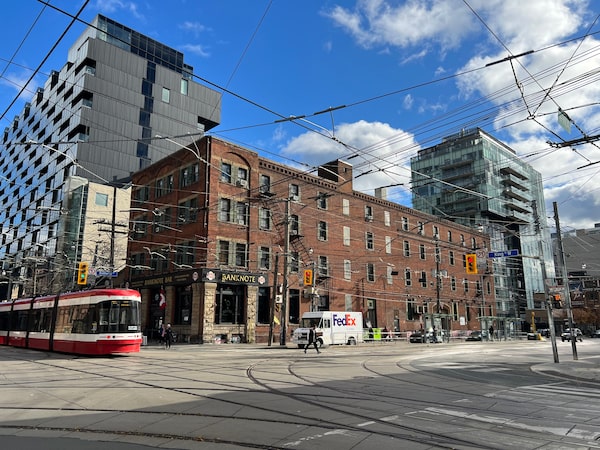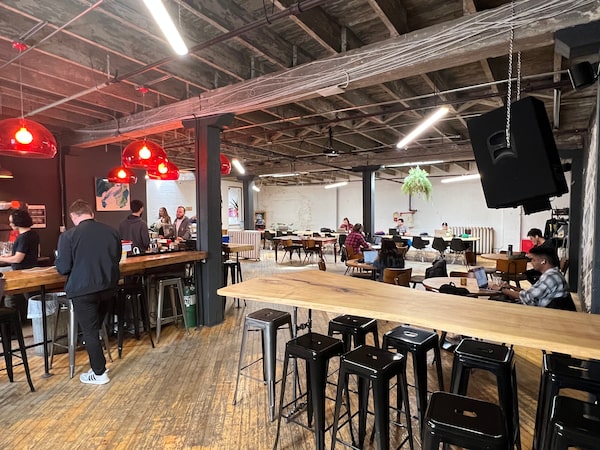
Co-working company Project Spaces in downtown Toronto needed to pivot its marketing strategy to attract more local residents and it began using QR codes on its posters.
As offices closed down and people avoided public transit in the early days of the pandemic, Project Spaces, a co-working business with two locations in downtown Toronto, needed to pivot its marketing strategy to attract more local residents.
“That’s when it hit me: millions of people live around the King and Bathurst area (in Toronto), they’re walking around, let’s get in front of people who don’t need to ride transit to get here,” said Project Spaces co-founder Neil Martin. “QR codes had this resurgence as a result of COVID, so we decided to give that a try.”
Mr. Martin and his co-founder Jeffrey Howard embedded QR codes on posters they hung around the city, with unique codes for 11 different downtown neighbourhoods. Upon scanning, users were taken to a website where they could learn more about the co-working space, and the co-founders were able to see, in real time, which neighbourhoods had the most interested residents.
“We felt so comfortable that people would understand how to use QR codes – because they were made familiar in restaurants – that we never even put our website on the poster,” Mr. Howard says. “If you didn’t know how to use it, you’re probably not looking for a co-working space.”
Mr. Howard points out that the posters cost about a tenth as much as digital advertising while still providing valuable data, such as the user’s location, which was previously unavailable in analogue media. Now the pair is considering other opportunities to incorporate the technology into their co-working spaces, such as instructions on how to use the shared printer or asking members to leave a review as they wait for their food by scanning a code on the microwave.
Quick Response (QR) codes were first created by Japan’s automotive industry in 1994, as a way to share more information than was available using the universal product code (UPC) or bar code used previously. At the time users needed to download a special app to scan QR codes, but that changed in 2017, when Apple embedded a QR code scanner into its camera app.
The technology remained somewhat niche until the pandemic, when QR codes were widely utilized by restaurants for contact tracing and digital menus, and by public health agencies for vaccine credentials. Now that the public is accustomed to scanning the small square symbols with their mobile devices, an array of businesses are finding unique ways to incorporate QR codes into their products and services.
“Two years ago when we started, I was basically going door to door, educating people about this,” says Shane Butler, director of operations for Toronto-based Candr, which helps businesses and individuals utilize the technology. “We don’t have that education problem anymore; when someone sees a QR code they know how to scan it.”
Mr. Butler says the company was founded two years ago to help restaurants streamline contact tracing and it is working with a wide range of brands and industries to use QR codes to solve a slew of problems. For example, Candr is partnering with brands to incorporate QR codes into live events, business cards, condo corporations, museums, charitable organizations, physical promotional materials, even funerals.
“The beauty of the QR code is that anyone can make one. We don’t need any special software, we don’t need a special domain name,” says Candr CEO Richard Hyatt, adding that generating a QR code is free. “Creating the QR code is not the difficult part, the difficult part is making it so what you serve up from that QR code is fast and relevant.”
Part of what makes the QR code such an elegant solution is its ability to enrich real-world objects – such as a billboard, business card or food packaging – with digital information. Brands are able to offer significantly more information than what would typically fit on those mediums, and in a variety of formats, including images and videos. They can also collect valuable data about how the information is used, and change it as needed.
“People are asking for more information, but space is limited on a package, and you don’t want to confuse people too much, so the QR code will remain an optimal portal to more information,” says Sylvain Charlebois, a professor and director of the Agri-Food Analytics Lab at Dalhousie University. “With the information given through a QR code, you are letting the consumer decide whether or not this [food item] is consistent with his or her expectations.”
Mr. Charlebois explains that consumers have been demanding more information about their food – such as where it comes from, what ingredients are used, nutritional data, allergy information, information about pesticide and GMOs, recipes and more – and now the industry has a tool for providing it.
“A lot of people weren’t asking certain questions because they felt the industry couldn’t answer them, but now they can,” he says. “It makes the industry much more accountable, and much more transparent, which is something a lot of people wanted even before the pandemic but didn’t know what that would look like.
“The QR code will make things easier for both consumers and the industry.”

The interior of Project Spaces, which used QR codes to share its website. QR Codes saw a resurgence during the pandemic, when they were used by restaurants for contact tracing and digital menus, and by public health agencies for vaccine credentials.